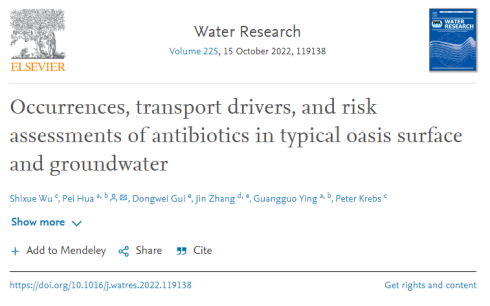
Graphical Abstract
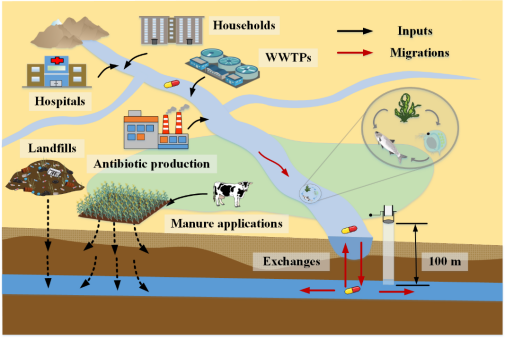
Main content
This study investigated the distribution patterns and potential risks of antibiotics in the surface and groundwater, as well as the connections between antibiotics in the surface–groundwater system in a typical oasis. The major findings are as follows: (1) groundwater showed higher detection frequencies and greater concentrations of antibiotics compared with surface water; (2) consumption pattern, antibiotic characteristics, and overlying soil properties contributed to the dissimilarity in antibiotic behavior between surface water and adjacent groundwater; (3) vertical infiltration had limited effects on antibiotic exchange in surface–groundwater systems because of the high potential evaporation and low water storage; and (4) erythromycin-H2O and lincomycin were the greatest contributors to antibiotic risks to the aquatic ecosystem. This study highlights the importance of regular groundwater monitoring and provides insights into the fate of antibiotics in water systems.
Introduction
Pharmaceutical concentrations in more than 25% of global river samples exceeded the threshold of causing antibiotic resistance. Thus, a comprehensive understanding of antibiotic contamination in waters is required for clean water availability and environmental sustainability. However, antibiotic occurrences in surface–groundwater systems are not well-understood. Moreover, drylands largely act as rangelands for livestock production, which potentially introduces a large burden of antibiotics into the environment. Meanwhile, drylands are the most vulnerable areas because of their exploited resources and increasing stress from climate change, causing a lack of resistance to environmental pollution. Therefore, the environmental behaviors of antibiotic residues in surface–groundwater systems are of great concern for the ecological safety of stakeholders and policymakers, especially in arid regions. Professor Pei Hua's group investigated the occurrence of thirty-one antibiotics in the surface water and adjacent groundwater in the Xinjiang Uygur Autonomous Region, China. Target compounds were quantified using ultra-performance liquid chromatography coupled with tandem mass spectrometry. Data were analyzed mainly based on heatmap analysis, redundancy analysis, and risk quotient approach.
Guide reading
(1) Antibiotic occurrences
We analyzed the concentration and composition of thirty-one target antibiotics in surface and groundwaters. The results showed that twenty of thirty-one antibiotics were detected in the surface water. Total concentrations of detected antibiotics varied from 17.37 to 84.09 ng L-1 in surface waters. Fluoroquinolones were the predominant antibiotics in the studied area. The median concentration of antibiotics showed the pattern of norfloxacin (4.86 ng L-1) > ciprofloxacin (3.93 ng L-1) > pefloxacin (3.39 ng L-1) in surface waters
In groundwaters, twenty-four of the target antibiotics were detected, and total concentrations of the thirty-one antibiotics ranged from 16.38 to 277.41 ng L-1. Fluoroquinolones were the dominant component of the total concentration. The order of individual antibiotic concentration was pefloxacin (6.30 ng L-1) > norfloxacin (4.33 ng L-1) > ciprofloxacin (2.68 ng L-1).
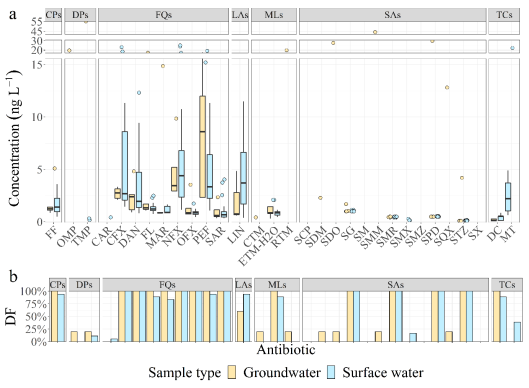
Figure 1. Concentrations (a) and detection frequencies (b) of target antibiotics
(2) Antibiotic interactions in surface−groundwater systems
the distribution patterns of antibiotics in surface water and groundwater were compared to clarify the interactions of antibiotics in surface−groundwater systems. The results showed that antibiotic concentrations in the groundwater were higher than those in the surface water. The higher contamination of groundwater by antibiotics could be explained by the aeolian sandy soil texture in the Qira Oasis, which is located on the verge of the Taklamakan Desert. Soils with higher sandy minerals are prone to have better permeability and low antibiotic retention capacity, which results in a greater migration of pollutants from soil to groundwater. Similarly, diaminopyrimidines and sulfonamides concentrations in the groundwater were higher than the corresponding concentration in the surface water. In contrast, lincosamide and tetracyclines were prone to be loaded in the surface water.
The heatmap in Figure 2(c) depicted the distribution patterns of antibiotics. Notably, although the groundwater sampling sites (cluster I and cluster III) are geographically closer to surface water sites near the Qira River (cluster V), their antibiotic distribution patterns were dissimilar. This finding revealed that vertical infiltration and subsequent leaching from surface water did not govern the fate of antibiotics in groundwater in arid regions because of water deficiency.
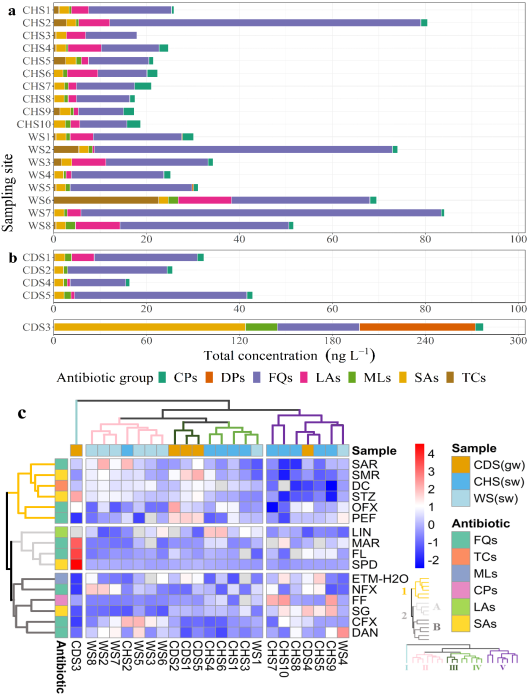
Figure 2. Site-specific antibiotic concentrations and composition profiles in surface water (a) and groundwater (b); (c) Heatmap of antibiotics clustered by concentration profiles
(3) Factors influencing antibiotic distributions
Redundancy analysis (RDA) was conducted to identify the potential factors influencing antibiotic distribution in the surface-groundwater system. The results (Figure 3) demonstrated that the oxidation-reduction potential (p < 0.01) and dissolved oxygen (p < 0.05) jointly negatively affected the distribution of antibiotics in surface water. The main explanation is that an abundant microbial population in an aerobic environment promotes antibiotic removal and causes a decrease in antibiotic concentrations. However, in groundwater, no significant relationships were found between any values of environmental factors and antibiotic group concentrations (p > 0.05).
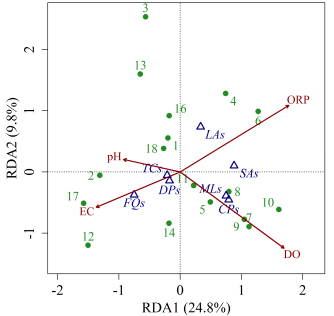
Figure 3. Redundancy analysis (RDA) ordination triplots.
(4) Risk assessment
The ecological risks of antibiotics in surface water and groundwater were depicted in Figure 4, including acute and chronic risks at three trophic levels. The results suggested that antibiotics in 98.9% of surface water and 99.1% of groundwater did not pose significant risks (risk quotient value < 0.01) to aquatic species. The differences in the ecological risk posed by antibiotics between the surface and groundwater were not significant (p > 0.05). Nevertheless, risk quotient values for algae were significantly higher than those for daphnids and fish (both p < 0.01).
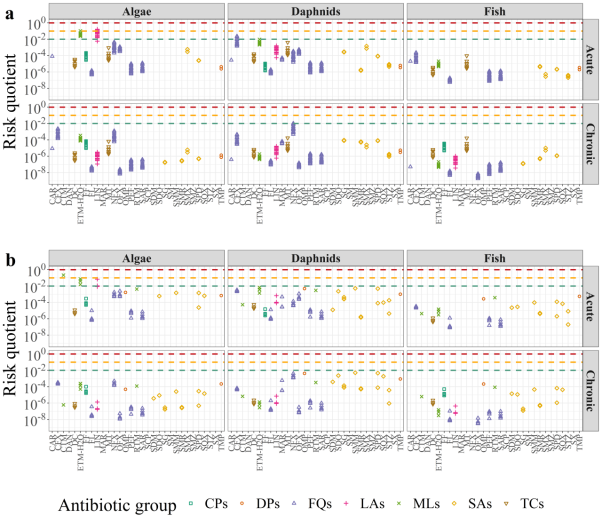
Figure 4. Ecological risk assessment of antibiotics (a) surface water; (b) groundwater.
Reference:
Wu, S., Hua, P., Gui, D., Zhang, J., Ying, G., Krebs, P., 2022. Occurrences, Transport Drivers, and Risk Assessments of Antibiotics in Typical Oasis Surface and Groundwater. Water Res. 119138. https://doi.org/https://doi.org/10.1016/j.watres.2022.119138
DOI link: https://doi.org/10.1016/j.watres.2022.119138